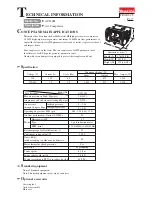
15
AIRSTROKE ACTUATION
SELECTION
1. Refer to the selection guide on page 32 for Airstroke force
and stroke capabilities. After your list of possibilities has been
reduced to one or two air springs, then turn to the individual
data page for more detailed information on those parts.
2. STROKE: The maximum STROKE CAPABILITY is the dif-
ference between the height corresponding to the “start of
the shaded area” minus the minimum height. This entire
stroke,
or any portion thereof, may be used. If an internal
rubber bumper is required, please note that the minimum
height is increased, and therefore, the total stroke is
decreased.
3. FORCE: Read the forces directly from the static data chart,
or, use the force table located under the chart. Notice that
the force generally decreases as height increases. This fea-
ture is discussed in detail on page 12 in the section entitled
“How to Use the Static Data Chart.”
4. SELECT THE END CLOSURES AND AIR INLET SIZE:
Most Airstroke actuators are available with permanently
attached plates or bead ring attachments. If an alternate end
closure option is available, it is so stated under the cross
sectional view of the part. Please refer to page 6 for a
detailed discussion of end closure options.
DOWN AND UP STOPS
Positive stops in both directions (compression and exten-
sion) should always be used with Airstroke actuators .
1. In COMPRESSION, the minimum height shown for each air
spring is at, or slightly above the PINCH POINT of the bellows.
Here is a #22 shown in the collapsed or “pinch point” condition:
The bellows can be damaged if allowed to constantly bot-
tom out as shown above; therefore, a downstop is required
to prevent this. An external downstop can be something as
simple as a steel block and should be sized at or slightly
greater than the minimum height of the Airstroke. In our #22
example, the block would need to be at least 3.0 inches
high. If an external downstop cannot be used, many parts
are available with internal rubber bumpers (shown as a
dotted line in the cross-sectional view of the air spring
where available).
2. In EXTENSION, an upstop is required to prevent the air
spring from overextending at heights into the shaded area of
the graph. The reasons for this are twofold: a) the life of the
bellows may be reduced and b) the crimp may open up,
allowing the bellows bead to blow out of the metal end clo-
sure. There are many ways to design-in an upstop, including
a. a chain,
b. a cable,
c. contacting a metal stop, etc.
RETURN
An Airstroke actuator is a
single acting device. To return the
Airstroke to its minimum height (for another cycle or stroke),
some return force must be used. Gravity acting on the load
may be all that’s required. The force to collapse the convoluted
type Airstrokes to minimum height is given in the order block
section for each part. If the load is not sufficient, then a second
Airstroke or coil spring may be required.
GUIDING
An Airstroke follows the path of least resistance; therefore, the
actuator should be guided in most instances. This is often eas-
ily accomplished in the mounting geometry.
ANGULAR CAPABILITY
An Airstroke actuator can stroke through an arc (without a cle-
vis). Angular motion of up to 30 degrees is possible. When
using an actuator with the mounting plates at an angle to each
other, observe the following:
a. Measure force at the height between the plate centers.
b. Measure maximum height at the side separated
the furthest.
c. Measure minimum height at the side collapsed the most.
3.0
















































